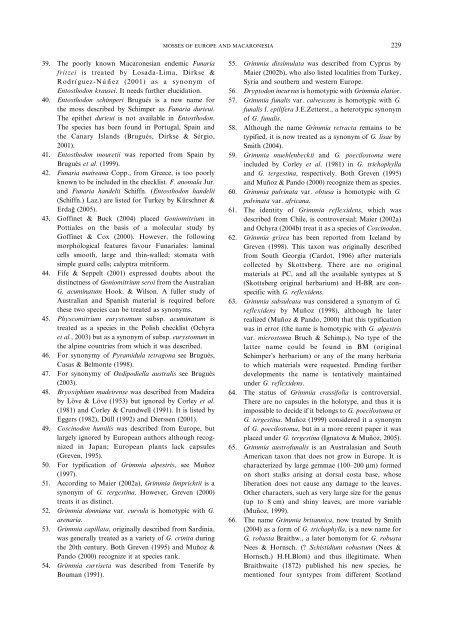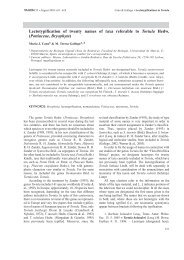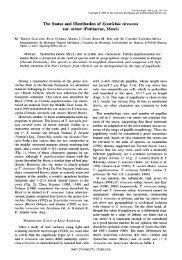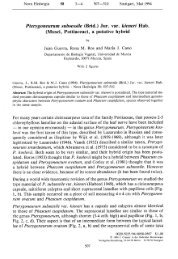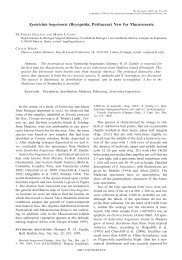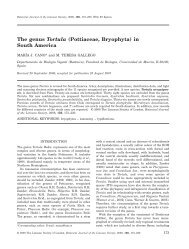Bryological Monograph An annotated checklist of the mosses of ...
Bryological Monograph An annotated checklist of the mosses of ...
Bryological Monograph An annotated checklist of the mosses of ...
You also want an ePaper? Increase the reach of your titles
YUMPU automatically turns print PDFs into web optimized ePapers that Google loves.
MOSSES OF EUROPE AND MACARONESIA 22939. The poorly known Macaronesian endemic Funariafritzei is treated by Losada-Lima, Dirkse &Rodríguez-Núñez (2001) as a synonym <strong>of</strong>Entosthodon krausei. It needs fur<strong>the</strong>r elucidation.40. Entosthodon schimperi Brugués is a new name for<strong>the</strong> moss described by Schimper as Funaria durieui.The epi<strong>the</strong>t durieui is not available in Entosthodon.The species has been found in Portugal, Spain and<strong>the</strong> Canary Islands (Brugués, Dirkse & Sérgio,2001).41. Entosthodon mouretii was reported from Spain byBrugués et al. (1999).42. Funaria maireana Copp., from Greece, is too poorlyknown to be included in <strong>the</strong> <strong>checklist</strong>. F. anomala Jur.and Funaria handelii Schiffn. (Entosthodon handelii(Schiffn.) Laz.) are listed for Turkey by Kürschner &Erdağ (2005).43. G<strong>of</strong>finet & Buck (2004) placed Goniomitrium inPottiales on <strong>the</strong> basis <strong>of</strong> a molecular study byG<strong>of</strong>finet & Cox (2000). However, <strong>the</strong> followingmorphological features favour Funariales: laminalcells smooth, large and thin-walled; stomata withsimple guard cells; calyptra mitriform.44. Fife & Seppelt (2001) expressed doubts about <strong>the</strong>distinctness <strong>of</strong> Goniomitrium seroi from <strong>the</strong> AustralianG. acuminatum Hook. & Wilson. A fuller study <strong>of</strong>Australian and Spanish material is required before<strong>the</strong>se two species can be treated as synonyms.45. Physcomitrium eurystomum subsp. acuminatum istreated as a species in <strong>the</strong> Polish <strong>checklist</strong> (Ochyraet al., 2003) but as a synonym <strong>of</strong> subsp. eurystomum in<strong>the</strong> alpine countries from which it was described.46. For synonymy <strong>of</strong> Pyramidula tetragona see Brugués,Casas & Belmonte (1998).47. For synonymy <strong>of</strong> Oedipodiella australis see Brugués(2003).48. Bryoxiphium madeirense was described from Madeiraby Löve & Löve (1953) but ignored by Corley et al.(1981) and Corley & Crundwell (1991). It is listed byEggers (1982), Düll (1992) and Dierssen (2001).49. Coscinodon humilis was described from Europe, butlargely ignored by European authors although recognizedin Japan; European plants lack capsules(Greven, 1995).50. For typification <strong>of</strong> Grimmia alpestris, see Muñoz(1997).51. According to Maier (2002a), Grimmia limprichtii is asynonym <strong>of</strong> G. tergestina. However, Greven (2000)treats it as distinct.52. Grimmia donniana var. curvula is homotypic with G.arenaria.53. Grimmia capillata, originally described from Sardinia,was generally treated as a variety <strong>of</strong> G. crinita during<strong>the</strong> 20th century. Both Greven (1995) and Muñoz &Pando (2000) recognize it at species rank.54. Grimmia curviseta was described from Tenerife byBouman (1991).55. Grimmia dissimulata was described from Cyprus byMaier (2002b), who also listed localities from Turkey,Syria and sou<strong>the</strong>rn and western Europe.56. Dryptodon incurvus is homotypic with Grimmia elatior.57. Grimmia funalis var. calvescens is homotypic with G.funalis f. epilifera J.E.Zetterst., a heterotypic synonym<strong>of</strong> G. funalis.58. Although <strong>the</strong> name Grimmia retracta remains to betypified, it is now treated as a synonym <strong>of</strong> G. lisae bySmith (2004).59. Grimmia muehlenbeckii and G. poecilostoma wereincluded by Corley et al. (1981) in G. trichophyllaand G. tergestina, respectively. Both Greven (1995)and Muñoz & Pando (2000) recognize <strong>the</strong>m as species.60. Grimmia pulvinata var. obtusa is homotypic with G.pulvinata var. africana.61. The identity <strong>of</strong> Grimmia reflexidens, which wasdescribed from Chile, is controversial; Maier (2002a)and Ochyra (2004b) treat it as a species <strong>of</strong> Coscinodon.62. Grimmia grisea has been reported from Iceland byGreven (1998). This taxon was originally describedfrom South Georgia (Cardot, 1906) after materialscollected by Skottsberg. There are no originalmaterials at PC, and all <strong>the</strong> available syntypes at S(Skottsberg original herbarium) and H-BR are conspecificwith G. reflexidens.63. Grimmia subsulcata was considered a synonym <strong>of</strong> G.reflexidens by Muñoz (1998), although he laterrealized (Muñoz & Pando, 2000) that this typificationwas in error (<strong>the</strong> name is homotypic with G. alpestrisvar. microstoma Bruch & Schimp.). No type <strong>of</strong> <strong>the</strong>latter name could be found in BM (originalSchimper’s herbarium) or any <strong>of</strong> <strong>the</strong> many herbariato which materials were requested. Pending fur<strong>the</strong>rdevelopments <strong>the</strong> name is tentatively maintainedunder G. reflexidens.64. The status <strong>of</strong> Grimmia crassifolia is controversial.There are no capsules in <strong>the</strong> holotype, and thus it isimpossible to decide if it belongs to G. poecilostoma orG. tergestina. Muñoz (1999) considered it a synonym<strong>of</strong> G. poecilostoma, but in a more recent paper it wasplaced under G. tergestina (Ignatova & Muñoz, 2005).65. Grimmia austr<strong>of</strong>unalis is an Australasian and SouthAmerican taxon that does not grow in Europe. It ischaracterized by large gemmae (100–200 mm) formedon short stalks arising at dorsal costa base, whoseliberation does not cause any damage to <strong>the</strong> leaves.O<strong>the</strong>r characters, such as very large size for <strong>the</strong> genus(up to 8 cm) and shiny leaves, are more variable(Muñoz, 1999).66. The name Grimmia britannica, now treated by Smith(2004) as a form <strong>of</strong> G. trichophylla, is a new name forG. robusta Braithw., a later homonym for G. robustaNees & Hornsch. (? Schistidium robustum (Nees &Hornsch.) H.H.Blom) and thus illegitimate. WhenBraithwaite (1872) published his new species, hementioned four syntypes from different Scotland


